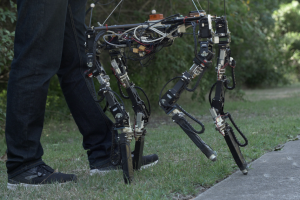Dubbed ‘Dyret’ (Dynamic Robot for Embodied Testing), the word means “the animal” in Norwegian.
The team – led by senior lecturer Tønnes Nygaard, at the university’s Department of Informatics – had previously been working on robotic adaptability within more controlled indoor conditions. Since then they have worked with other researchers at The Commonwealth Scientific and Industrial Research Organisation (CSIRO) in Australia to help specialise in testing self-learning robots outdoors.
You can read more here.
Camera and sensors
They believe this could be the first quadruped robot that is able to automatically adapt its morphology to different conditions in such unstructured environments. It uses a combination of a camera, to see how rough the terrain is, and sensors, to feel how hard the walking surface is, to learn more about what’s in front of it.
“We have shown the benefits of allowing a robot to continuously adapt its body shape,” said Nygaard. “Our physical robot also proves that this can easily be done with today’s technology.”
“This was previously considered too hard to achieve in the real world. Through the robot and our experiments, we’ve definitely shown that it’s possible.”
The results of their work have just been published in the journal Nature Machine Intelligence ( Tønnes Nygaard, Charles P. Martin, Jim Tørresen, Kyrre Glette and David Howard: Real-world Embodied AI Through a Morphologically Adaptive Quadruped Robot, Nature Machine Intelligence, March 2020).
It seems to be a trade-off between shorter legs for irregular surfaces and longer legs for speedy progress on more predictable one.
One possible application could be space, and extra-terrestrial exploration.
The researchers have made the technology open source, which could help others to extend – pun intended! – the adaptive robot to new applications.
[embed]https://www.youtube.com/watch?v=DLVc0JOWaUM[/embed]
Thanks to Sue P. for highlighting this one.
Image: Tønnes Nygaard / The University of oslo
[Via New Atlas]
[ad_2]





0 Comments: